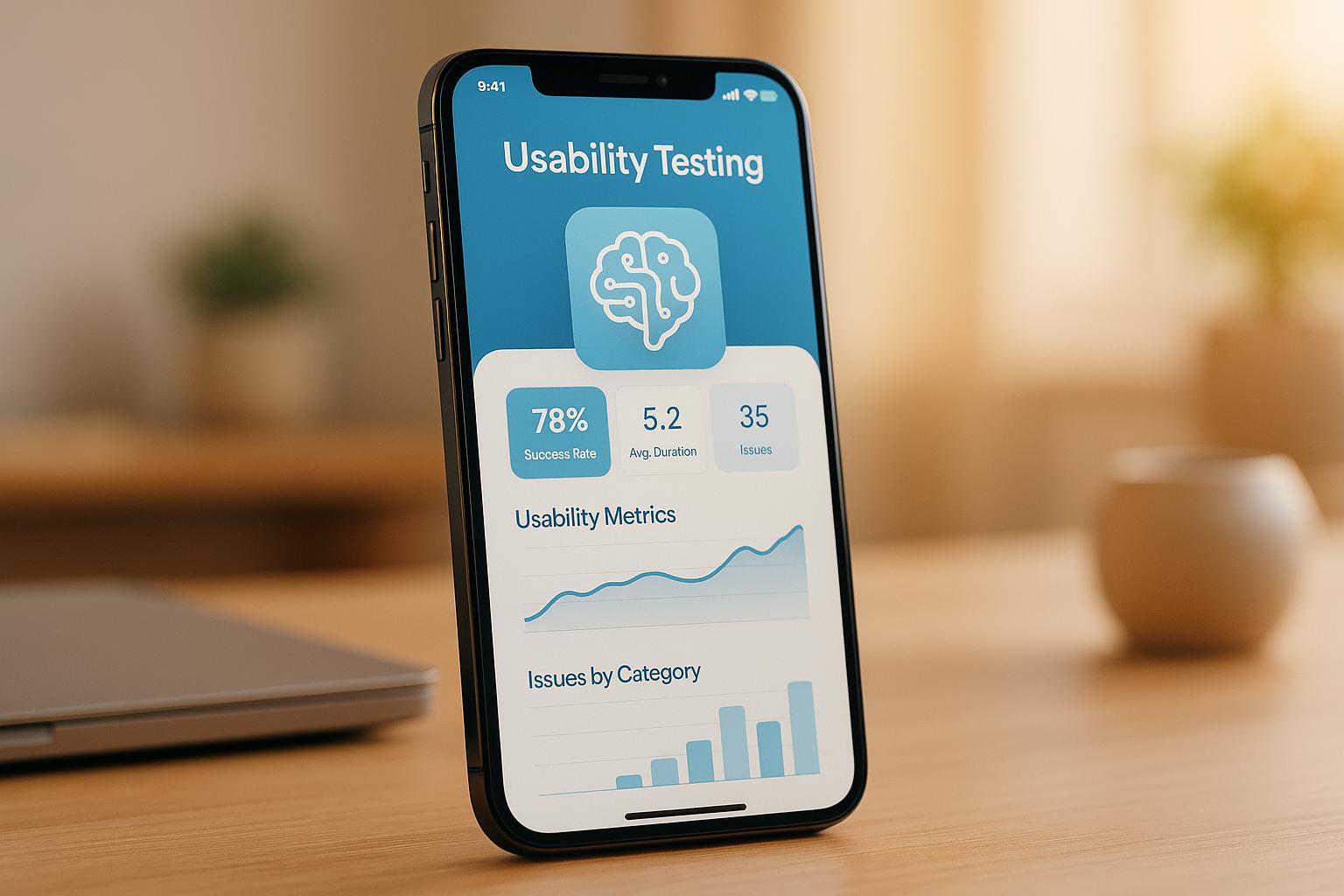
AI in Mobile App Usability Testing: Benefits
AI is transforming mobile app usability testing by automating time-consuming tasks, reducing bias, and scaling processes to handle diverse devices and user behaviours. Instead of relying on lengthy manual testing, AI systems provide faster, data-driven insights into app performance. Here’s what AI brings to usability testing:
- Automation: Speeds up participant recruitment, test script creation, and data analysis.
- Real-Time Analysis: Tracks user behaviour, identifies friction points, and monitors performance metrics instantly.
- Cross-Platform Testing: Simultaneously tests apps on various devices, operating systems, and screen sizes.
- Improved Insights: Combines user feedback with performance data for precise problem detection.
- Scalability: Handles large-scale and multilingual testing efficiently.
AI helps teams identify issues early, deliver apps faster, and ensure a better user experience while reducing costs. Companies like Digital Fractal Technologies Inc. already leverage these tools to refine app performance for diverse users.
How AI is Transforming Mobile Testing: Faster, Smarter, Better
AI Automation in Usability Testing Workflows
Usability testing has traditionally been a time-intensive process, requiring meticulous effort to recruit participants, schedule sessions, gather data, and compile feedback. With the introduction of AI automation, much of this labour-intensive work is being streamlined. By automating repetitive tasks, teams can now dedicate their energy to the core objective: understanding user behaviour and refining user experiences. Here’s a closer look at how AI is reshaping usability testing workflows.
AI-powered systems can now oversee the entire testing process, from participant recruitment to data collection and analysis. Tasks that once took weeks can now run seamlessly in the background, allowing for continuous testing without interrupting workflows. This shift is transforming usability testing into a faster, more efficient process.
Automating Repetitive Tasks
AI simplifies and accelerates many of the manual tasks involved in usability testing. For instance, participant recruitment is completed in minutes, as AI tools evaluate user profiles and match them to testing criteria. Similarly, data aggregation and session scheduling are handled effortlessly, with AI sending reminders, coordinating availability across time zones, and rescheduling as needed.
Another game-changer is the automation of test scripts and user journey creation. AI systems can analyse app functionality and user flow patterns to generate test scenarios that cover essential interactions. This eliminates the need for manual script drafting, ensuring consistent and thorough testing coverage across cycles.
These automated processes not only save time but also enhance testing accuracy. By feeding directly into real-time tracking, they make usability testing more efficient and responsive.
Real-Time User Behaviour Tracking
One of AI’s standout capabilities in usability testing is its ability to monitor user behaviour in real time. Real-time tracking captures every interaction, highlighting friction points like repeated clicks on inactive elements or frequent navigation errors. These insights allow teams to address problems immediately, preventing them from affecting a broader user base.
AI also automates heat mapping and user journey analysis during testing sessions. It identifies where users spend the most time, which elements they interact with most, and where they encounter difficulties. These visual insights, which would take hours to compile manually, are now available instantly.
In addition to tracking behaviour, AI monitors performance metrics like app response times, loading speeds, and error rates. For example, if a user experiences slow loading or encounters a bug, the system logs the issue alongside the specific actions that triggered it. This level of detail helps developers pinpoint and resolve problems more effectively.
Another layer of insight comes from emotional response tracking. By analysing patterns like hesitation, navigation choices, and interaction speed, AI can infer user emotions such as frustration, confusion, or satisfaction. These qualitative insights add depth to the quantitative data, offering a fuller picture of the user experience.
AI automation is shifting usability testing from a reactive to a proactive approach. Instead of waiting for issues to emerge post-launch, teams can identify and resolve usability challenges continuously throughout development. This creates a more dynamic and user-focused development process, where real-time feedback directly shapes design decisions.
Faster Testing and Better Scalability with AI
The use of AI in usability testing has completely reshaped how quickly and efficiently tests can be conducted. AI-driven platforms not only speed up the process but also make it possible to engage a wide range of participants from around the world. This shift tackles long-standing issues like lengthy development cycles and a lack of participant diversity.
AI’s ability to handle multiple tasks simultaneously is a game-changer. It can run various testing scenarios at the same time across different user groups and platforms. What used to be a slow, step-by-step process is now a streamlined operation, delivering faster and more comprehensive results. This efficiency has drastically shortened testing timelines.
Reduced Testing Timelines
Traditional usability testing often involves time-consuming steps like finding participants, scheduling sessions, collecting data, and analysing results. AI simplifies these tasks by automating them. For example, instead of manually recruiting participants, AI-powered platforms can quickly match participant profiles to testing criteria, speeding up recruitment. Data collection is synchronized with user interactions, providing instant insights.
Research shows that AI-assisted unmoderated usability testing enables larger participant groups to be recruited more quickly and at a lower cost compared to traditional methods. This efficiency also supports thorough testing across multiple platforms, ensuring designs are validated on a broader scale.
Testing Across Multiple Platforms
For mobile apps, consistency is key – whether on different devices, operating systems, or screen sizes. AI makes cross-platform testing more efficient by running identical scenarios on platforms like iOS and Android simultaneously. This approach helps designers pinpoint platform-specific usability issues, ensuring a seamless experience for all users.
AI also removes geographical barriers, enabling testing across various devices, screen resolutions, and OS versions without limitations. This ensures that data collection is accessible and inclusive.
Additionally, Large Language Models (LLMs) enhance the scalability of usability testing. They refine data collection and provide detailed feedback from large numbers of users. Many AI platforms offer extensive tester panels and allow targeting of specific demographics, ensuring a more representative sample. AI moderation further boosts scalability by enabling dynamic, conversational testing in unmoderated studies. This is especially valuable for testing scenarios that involve multiple languages, time zones, and cultural contexts.
Looking ahead, advancements in AI tools are expected to make usability testing even more inclusive and accessible, ensuring designs meet the needs of a diverse range of users.
Better Accuracy and User Insights
AI takes user interaction data and transforms it into actionable insights that go beyond what manual reviews can uncover. Traditional testing methods often rely on subjective interpretations, which can skew results. In contrast, AI uses a consistent, data-driven approach to evaluate user behaviour. This helps development teams pinpoint areas where app design and functionality could be improved.
Eliminating Human Bias
One of the challenges of manual testing is the potential for bias. AI eliminates this by analysing performance metrics – like task completion rates, time spent on tasks, and error frequencies – using the same criteria every time. This consistent evaluation leads to more reliable testing outcomes, giving teams the clarity they need to make better decisions during the app development process.
Pattern Recognition and Predictive Analytics
Machine learning algorithms excel at spotting patterns in user engagement. They can identify early signs of usability issues, flag potential challenges, and track response times across different platforms. This allows teams to address problems before they escalate. AI also helps detect signs of cognitive strain or user frustration, while simultaneously comparing behaviours across operating systems. This ensures that core functionality remains consistent, no matter the platform.
sbb-itb-fd1fcab
Combining Qualitative and Quantitative Data
By blending qualitative feedback with quantitative data, teams can gain a richer understanding of usability issues. AI’s precision and ability to process user insights make this integration even more effective.
Traditionally, usability testing has kept feedback and performance metrics separate. AI bridges this gap, offering a unified perspective that highlights clear priorities for refining design. For instance, if users mention that an app feels sluggish, AI can match this with data on loading times, tap response speeds, or task completion rates. This direct comparison ensures teams focus on changes that will have the greatest impact on user experience.
Sentiment Analysis in User Feedback
Natural language processing (NLP) takes unstructured user comments and transforms them into actionable insights. Instead of manually sorting through countless feedback forms, AI algorithms can process large volumes of text, identifying emotional trends and pinpointing specific pain points that might otherwise go unnoticed.
Through sentiment analysis, AI evaluates user comments to quantify emotions like frustration, confusion, or satisfaction. It doesn’t just rely on keywords but considers the context, ensuring the analysis reflects the true sentiment behind the feedback.
Linking Feedback with Performance Metrics
AI shines in connecting user feedback with performance data. For example, if sentiment analysis identifies complaints about navigation, AI can link this with metrics like task duration or error rates to confirm and prioritize the problem areas.
Sometimes, even when users complete a process – like checkout – they may still report difficulties. In such cases, AI can reveal that the issue lies in design clarity rather than functionality. Similarly, features that don’t receive direct complaints might still show high error rates or unusual interaction patterns, hinting at deeper usability concerns.
Practical Applications of AI Usability Testing
AI usability testing is reshaping how mobile apps are developed, offering faster results, greater precision, and cost savings compared to traditional methods. By integrating AI into usability testing, organizations across various industries have seen tangible benefits, including shorter development cycles, improved user experiences, and reduced expenses. These advancements build on earlier gains in speed and accuracy, extending AI’s impact into practical scenarios.
Industries with intricate workflows, such as construction, energy, and the public sector, stand to gain significantly from these advanced testing techniques. AI-driven methods help identify usability issues early in development, ensuring mobile apps perform reliably even in high-pressure or demanding environments.
Case Studies and Measured Results
Research highlights the clear advantages of AI-powered usability testing. Companies adopting these methods report reduced testing timelines while uncovering more usability issues than traditional manual methods. This dual benefit of efficiency and thoroughness makes AI testing an attractive option for developers.
In the public sector, AI-driven interface improvements have shown measurable results, such as fewer support requests and higher user satisfaction rates. These outcomes demonstrate both operational and financial benefits, encouraging broader adoption of AI-based testing strategies.
Large-Scale and Multilingual Testing
AI usability testing also excels in handling large-scale and multilingual challenges. AI systems can simultaneously evaluate interfaces in multiple languages, ensuring consistent quality across diverse linguistic and regional contexts. This capability is especially valuable in a country like Canada, where bilingualism and cultural diversity are key considerations.
Additionally, AI can process feedback from vast user bases, identifying patterns and specific usability issues that might be missed in smaller, manual testing sessions. This scalability allows companies to design interfaces that cater to varied user needs while maintaining high standards of usability.
Take Digital Fractal Technologies, for example. By integrating AI-powered usability testing into their mobile app development process, they combine the precision of AI with expert human oversight. This approach ensures that their applications meet stringent technical requirements while addressing the unique needs of diverse user groups and operating environments.
For Canadian organizations, the ability to conduct large-scale, multilingual testing ensures consistent and inclusive user experiences, making AI usability testing an essential tool in modern app development.
Conclusion: AI’s Role in Mobile App Usability Testing
AI has reshaped the way mobile app usability testing is conducted by simplifying complex tasks, offering real-time tracking, and analysing massive amounts of data. These advancements give development teams the tools to spot and fix usability issues faster than ever before.
By shortening development cycles and expanding test coverage, AI enables quicker app delivery and smoother updates. Its ability to detect patterns and analyse sentiment reduces human bias, uncovering subtle usability challenges that might otherwise go unnoticed. Paired with expert analysis, AI turns user feedback into actionable strategies for improvement.
For Canadian businesses, AI-driven testing supports large-scale, multilingual evaluations, ensuring mobile apps cater to the diverse needs of a multicultural population while maintaining consistent quality across regions.
In short, integrating AI into usability testing not only boosts performance but also enhances user satisfaction. In a competitive market, businesses that embrace AI in their testing workflows are better equipped to deliver exceptional user experiences while managing development costs efficiently. Companies like Digital Fractal Technologies Inc. are already leveraging these insights to create tailored mobile app solutions, making AI a key part of staying ahead in today’s digital economy.
FAQs
How does AI enhance the precision of mobile app usability testing compared to traditional methods?
AI brings a new level of accuracy to mobile app usability testing by leveraging advanced machine learning algorithms. These tools can analyse user interactions in detail, pinpointing issues with far more precision than traditional methods. Plus, because AI reduces human error and eliminates subjective bias, the results are consistent and dependable.
One standout advantage is how AI automates tasks like visual testing. It can carefully compare app interfaces across multiple devices and screen sizes, spotting inconsistencies that might slip past human testers. This not only speeds up the process of identifying problems but also provides deeper insights into user behaviour. The result? Apps that are more polished and better aligned with what users expect.
What advantages does AI bring to cross-platform usability testing for mobile apps?
AI brings some clear benefits when it comes to cross-platform usability testing for mobile apps. By automating repetitive tasks – like simulating user actions or spotting bugs – it speeds up the testing process significantly. This not only cuts down on manual work but also shortens the time it takes to get apps ready for release, helping teams deliver high-quality products faster.
Another major advantage is the improved accuracy and dependability AI offers. With features like predictive insights and self-healing test scripts that adjust to changes in an app’s functionality, AI ensures broader test coverage across different devices and operating systems. This leads to a smoother, more consistent experience for users. For developers, this means meeting user expectations more efficiently while saving both time and resources.
How does AI improve multilingual and large-scale usability testing?
AI plays a key role in improving multilingual usability testing by using natural language processing (NLP) models. These models can analyse user interactions in various languages, ensuring the feedback is precise and aligns with local nuances. This helps developers tailor apps to meet the needs of diverse audiences more effectively.
When it comes to large-scale testing, AI steps in to handle repetitive tasks, process massive amounts of user data, and provide insights that teams can act on quickly. This approach not only saves time but also makes it easier to scale testing efforts. As a result, usability issues can be identified and addressed efficiently, even for larger and more varied user groups.

